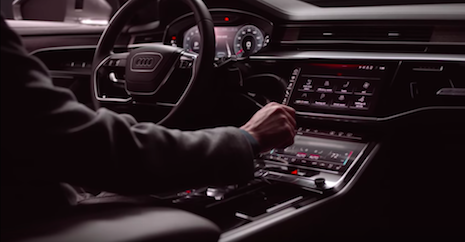- About
- Subscribe Now
- New York,
August 30, 2018

 Audi's in-car technology is focused on innovation. Image credit: Audi
Audi's in-car technology is focused on innovation. Image credit: Audi
Consumer satisfaction with new-vehicle technology has improved, but automakers need to be keen about what features drivers use the most to make the wisest investments of their efforts.
According to the J.D. Power 2018 U.S. Tech Experience Index (TXI) Study, navigation and voice recognition are among the most popular technologies used by drivers, but they are more likely to use their smartphones for those features than in-vehicle touchpoints. Automakers should instead focus on technology they alone can provide, though adoption of these advanced features varies widely among car manufacturers.
"Much of the increase in satisfaction is driven by highly-satisfying technologies, such as collision protection techs, increasing in penetration," said Kristin Kolodge, executive director of driver interaction and HMI research at J.D. Power, Costa Mesa, CA. "Voice recognition was another technology that had year-over-year improvement, with consumers reporting lower occurrence of difficulty understanding the technology and an increase in satisfaction."
The study was based on a survey of 14,800 drivers who purchased or leased a new 2018 model-year vehicle in the previous 90 days that is an all-new or redesigned model within the past three years. The survey was conducted between February and July 2018.
Technology adaptations
J.D. Power asks drivers about their experiences and interactions with 38 driver-centric vehicle technologies, which generally fall into the areas of entertainment and connectivity, comfort and convenience, driving assistance, collision protection, navigation and smartphone mirroring. Scores were based on a 1,000-point scale.
Factory-installed navigation systems are among the least popular features, with 19 percent of new-vehicle owners not using their systems. Seventy percent of those drivers instead use another device, primarily smartphones.
Apple's CarPlay is the favored smartphone mirroring option. Image credit: Apple
The majority of drivers who use smartphone applications for navigations turn to Google, with 56 percent relying on Google Maps the most and 16 percent using Waze, which is also owned by Google. Only 23 percent use Apple Maps most often, as Google Maps continues to be more popular even among iPhone users.
"The difference in usage rate is driven by usefulness and perceived accuracy," Ms. Kolodge said.
Drivers find Apple's CarPlay smartphone mirroring more satisfactory than Android Auto, with ratings of 777 and 748, respectively. These technologies work with drivers' smartphones to enable them to interact with their devices more easily through the built-in controls in the car.
The Lincoln MKX scored highest for car technology satisfaction in the midsize premium segment. Image credit: Lincoln
Luxury vehicles averaged 766 in overall satisfaction with new-vehicle technology, an improvement of 16 points from 2017. Comfort and collision protection saw the most forward momentum with increases of 22 and 18 points, respectively.
"There is a high occurrence of owners, 56 percent, who have avoided an accident in their first 90 days of ownership of their new vehicle due to one or more of the collision protection features," Ms. Kolodge said. "This quickly creates real value to the consumer and increases satisfaction as a result."
However, technology usage of different systems varies among automakers. While cars' voice recognition features are frequently used by 10 to 29 percent of drivers, 46 to 67 percent of owners use lane-keeping/centering systems.
Nonetheless, 23 percent say their lane-keeping assistance systems are bothersome, so there is room for automakers to improve in that area. Thoughtful technology investments will help manufacturers sell more vehicles, since 94 percent of drivers who rated their cars 900 or above recommend their models to family and friends.
"Automakers that create systems that aren’t being used are making investments in technology that are unlikely to be successful," Ms. Kolodge said.
Marketing innovations
Luxury automakers often attempt to differentiate amongst themselves by showcasing specific technologies, especially as automation and smartphone connectivity continue to appeal to affluents.
In Audi’s new video called "Audi Tech Defined: Man Machine Interface," the German automaker highlights some of the digital technology that goes into the making of its cars.
For example, with MMI, customers can speak out loud to interact directly with their car. A driver can simply say, "Take me to the theater,” and the car will automatically pull up the GPS on the digital display and begin navigation to the nearest theater.
Audi's digital interface is also equipped with haptic feedback, the combination of vibrations and other design tricks to make the pressing of a digital touchscreen button have the same feeling as pressing a physical button (see story).
The Lincoln Navigator won the Truck of the Year award at the 2018 North American International Auto Show, and the brand has wasted no time in capitalizing on this honor with a campaign centered on its in-vehicle technology.
Starring Grammy-winning R&B singer Ne-Yo, the campaign plays up one of the main features of the Navigator: Lincoln Play. Lincoln Play is a mobile app that controls the car’s entire entertainment system, allowing drivers to stream music and passengers in the backseat to watch movies or play games.
"The technology battle is primed with multiple, duplicative choices for consumers to choose," J.D. Power's Ms. Kolodge said. "User experience will be a key differentiator driving their choice."
Share your thoughts. Click here